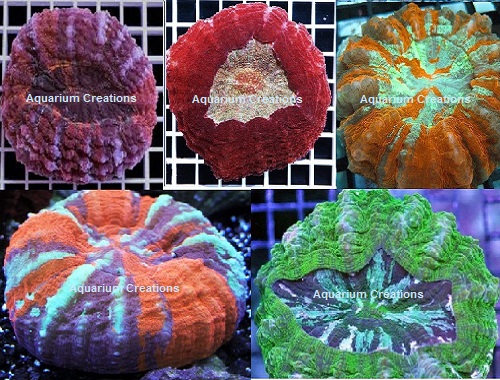The Fancy Doughnut Coral S. vitiensis, is found in many colors red, blue, Orange and green to name just a few. Some other common names for the Fancy Doughnut Coral are Scolymia Brain Coral, Button Scolymia Coral, Scolymia Meat Coral or simply Meat Coral. The Australian Fancy Doughnut Coral, Scolymia vitiensis is just perfect for beginners due to its hardy and undemanding nature. Of all the Scolymia corals, the Fancy Doughnut Coral is the easiest to maintain mostly because it is less sensitive to injury and not as susceptible to death from the stings of other corals. Only using low to moderate lighting is suggested, as well as lower water current to allow full expansion. Place them in the rock work rather than on the substrate, as they can be damaged if they get buried in sand. They are relatively slow growers so won't take over you tank anytime soon, but they do respond really well when being fed.
Fancy Doughnut Corals are found from Australia east to Fiji and the Marshall Islands. Around Australia they are found in the Great Barrier Reef, Coral Sea and south to Elizabeth and Middleton Reefs in the east, but are not found on the west coast. The skeletal structure of the Scolymia vitiensis can be cup shaped, saucer shaped, flat or dome shaped. They have similarities to the Cynarina Genus except their septa slope outward, are not as pronounced (tall and tooth like), and are more closely spaced. The septa is spiny around the outer rim and their skeleton is larger, denser and heavier than Cynarina. Scolymia vitiensis corals are usually solitary, but can be colonial, depending on the species. They have an oral disc with usually one mouth, but at times there may be a few more openings. Their flesh is heavier and more opaque (not clear) than the Cynarina species, and the tissue conforms to the shape of the skeleton. It can make small pimpled bumps on the surface, instead of exaggerated see through bubbled formations like that of the Cynarina genus.
Difficulty An easy to keep, hardy coral.
Aggressiveness This is a peaceful coral, they have feeder tentacles that come out at night. But due to their non-aggressive nature, they can sting others but more than likely they are the ones that will be stung.
Water-flow
It prefers Low to Moderate / turbulent.
Lighting
It prefers low to moderate lighting levels (PAR 50-150). T5's, Metal Halides, or LED's can all grow fungia plate corals when the proper PAR levels are provided. We recommend a 14-20K color spectrum for best coloration.
Tank Recommendations
Place in the rock work rather than on the substrate, as they can be damaged if they get buried in sand. Place in low current areas with low to moderate lighting.
Diet and Feeding
We recommend feeding minced 1/4" pieces shrimp, cyclopeeze, micro-plankton, brine shrimp, frozen mysis. Feed at night when tentacles are present. Feeding several times a week will help them grow faster, and keep them healthy.
|



